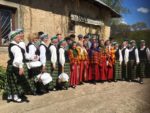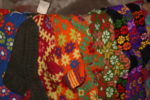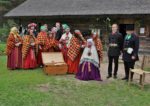Through the Land of Suiti
GENERAL INFORMATION
SEASON: January – December
FOR WHOM: individuals / groups
SERVICES INCLUDED: guided tour + entrances + local lunch
DURATION OF THE PROGRAMME: 5h
TYPE OF TRANSPORT: private driver/tour bus
PUBLIC TRANSPORTATION: 180 km
The Suiti are a community with some of the most colourful and unique cultural traditions in Kurzeme region and Latvia. This was acknowledged on October 1, 2009, when the cultural space of the Suiti was included in the UNESCO List of Intangible Cultural Heritage in Need of Urgent Safeguarding, indicating that these traditions are very fragile and must be safeguarded. The Suiti cultural space as an exceptional value of folk traditions, is also a part of the Latvian Cultural Canon. Manifestations of this intangible cultural heritage include traditional festivals, customs, oral traditions, traditional singing and music playing skills, folk costumes and culinary traditions. Since 2009, the Suiti community has been undergoing a renaissance, with people actively working to restore traditions and to ensure their sustainability and promotion at the local, national and international level. The survival of the cultural space is in the hands of the Suiti themselves, and this is closely linked to the practices and the creativity of community members. The Suiti believe the development of tourism in their cultural space to be of great importance in this. This means emphasising a niche in cultural tourism that is based on the broader promotion of the unique cultural heritage of the Suiti. Visiting the Suiti ethnographic region, the visitors will meet the folk group ‘Suitu Sievas’ to learn about local traditions, to sing and play games, dress in traditional costumes, participate in Bourdon Singing Master class.
• The “Rija” Suiti craftsmanship and art space is in the threshing barn of an old estate in Alsunga. There is a souvenir shop where you can purchase practical items such as shawls, gloves, stockings, dishes, herbal teas, etc. Creative children’s work- shops are available, and if you contact the venue in advance, you can meet Suiti women to learn about traditions, sing, and play games.
• The Livonian Order castle in Alsunga was built gradually between the 14th and 18th centuries and has been rebuilt several times. It is known that there was a fortified house in Alšvanga in 1341, and in 1372, work began on a square castle made of rocks. Defensive towers and other elements of the church were built between the 15th and 18th centuries. The Alsunga castle is unique in that it is one of the few Medieval buildings in Europe that has preserved its historical appearance.
• Dizgabalkalns Hill is an ancient Curonian castle mound in the very centre of Alsunga. It got its name in 1659 when General Berg from Kurzeme put cannons on it to attack Swedish forces that had established fortifications in the Alsunga castle. The hill is 8 to 10 metres high and 24 x 54 metres wide, offering a lovely view of the St Michael Roman Catholic Church, as well as the Alsunga windmill lake that is alongside it. On the other side of the street, to the West of the castle hill, there is a cemetery with cremation graves of Curonians that date back to the 11th–13th century. The Suiti celebrate Easter and other festive events on the hill.
• Spēlmaņu pub is located at the heart of Alsunga, where tourists can have the opportunity to enjoy hearty meal. Upon request, guests can sample traditional regional cuisine from Suiti, as well as take part in their preparation under the guidance of Suiti women. In addition to cooking, you can explore the richness of Suiti cultural heritage in the performances of the bands “Suiti women”, “Suiti men”, and “Suiti bagpipe players”.
• The St Michael’s Roman Catholic Church of Alsunga was built around 1625. For several cen- turies it was the main worship place for the Suiti community, supporting the community’s spir- ituality and identity. In 1882, the church was ex- panded into the form of a cross as seen today. Inside the church, you can see work done by the Dutch wood carver Johann Mertens around 1715. The organ was built by F. Weisenborn in Jēkabpils in 1893, and the altar painting dates back to 1910. Below the church is the bricked graveyard of the Schwerin dynasty.
• The Alsunga Tourist Information and Historical Heritage Centre has a permanent exhibition that features a Suiti living room and a kitchen, as well as liturgical apparel collection worn by Catholic priests. In the exhibition hall there are rotating exhibitions related to the history and present life of the Suiti women’s ethnographic ensemble. A special offer involves performances by ensem- bles “Suiti women”, “Suiti men” and “Suiti bagpipe players”.
• The “Austuve” and “Suiti kitchen” are creative workshop places located in the building of the Alsunga Administrative District Museum. You can see how Suiti folk costumes and elements are produced, learn more about weaving traditions and learn about the colourful apparel of the Suiti people, and dress up in Suiti traditional clothes. You can also try your hand at weaving under the guidance of experienced masters. In the “Suiti kitchen” you can learn about the culinary heritage of the Suiti people, as well participate in the mas- ter classes and learn how to make Suiti traditional sour bread (skābmaize), carrot pie (sklandrausis) and other traditional dishes.






